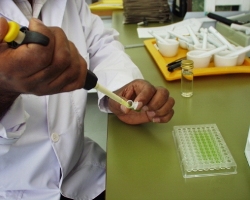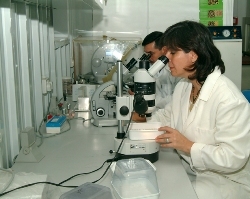Health diagnosis
.jpg) View section on seed health testing by clicking on the icon above. (0.7 MB) |
Page compiled by: Bioversity International/ILRI, Addis Ababa, Ethiopia (Alexandra Jorge); ILRI, Addis Ababa, Ethiopia (Jean Hanson) including information extracted from: Rao NK, Hanson J, Dulloo ME, Ghosh K, Nowel D and Larinde M. 2006. Manual of seed handling in genebanks. Handbooks for Genebanks No. 8. Bioversity International, Rome, Italy. 147pp.
The importance of plant health
Seed or plant health refers to the disease status of a seed or plant sample and the presence or absence of disease-causing organisms and pests.
|
Assessing seed health (photo: ILRI) |
|
Looking for infected seed (photo: ICARDA) |
|
Seeds contaminated with fungi (photo: ILRI) |
Why is plant health testing important
Crops are frequently infected with a range of common seed-borne or systemic pathogens that may not be visible or easily recognized during seed collection. Seed-borne or systemic inoculums may reduce longevity during storage and cause poor germination or field establishment. Seed-borne and systemic inoculums also are a source of infection and spread disease in the field, reducing the value of crops. Exchange of infected seeds or plant material may allow spread of diseases and pests into new regions. Genebanks should ensure that seeds or plant material prepared for conservation are free from seed-borne or systemc diseases and pests.
Common seed-borne or systemic pests and pathogens
There are four main types of common organisms that are carried in seeds or plant material and affect a wide range of crops:
- Fungi.
- Bacteria.
- Viruses.
- Insects.
Specific methods for detecting pathogens vary by organism and host, and specific methods are required for accurate identification of most pathogens.
See the safe movement of germplasm section on this site for lists of common pathogens of quarantine importance for a range of crops and information on best practices for safe movement of germplasm.
References and further reading
Albrechtsen SE. 2005. Testing methods for seed-transmitted viruses: Principles and protocols. Oxford University Press, UK.
CABI, Crop Protection Compendium. 2007. CD-ROM Edition. Available from: www.cabicompendium.org/cpc Date accessed: 24 March 2010.
EPPO (European and Mediterranean Plant Protection Organization) standards. The EPPO bulletin is available from: http://www3.interscience.wiley.com/journal/118486049/home Date accessed: 24 March 2010.
Comments (2)
-
Guest - Eleni
The Pdf file attached with this document is that of seed viability test. Would you please post the one for seed health testing. Thanks
0 Like -
Dear Eleni,
Please scroll down in the pdf until page 77 (page 29 of 36 of the pdf). There you will find the chapter on seed health.
The CGKB team0 Like








Leave your comments
Post comment as a guest